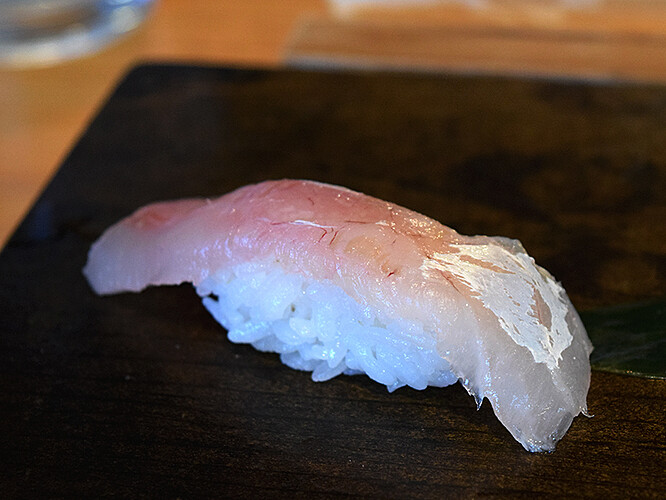Forgive me the lack of photos, I don’t usually take them (which I regret today).
I was in WeHo today for some business and was feeling peckish at a time when practically no real sushi places are open (3 pm). A few blocks away from the esteemed Jinpachi, the only place that was open within a short distance was this little hole-in-the-wall. Modern and chic, Nori looks like nothing so much as your average upscale roll-factory. Head Chef Eric is young-looking and speaks good English, which would normally be another two strikes against it. However, I decided to take a chance and sat down at the counter, asking if they served Omakase - which they did. Below is what I ate:
Bluefin Maguro - your standard piece of tuna. However, the quality of the shari, neta, and knifework was already a step above what I was expecting when I came in.
Hamachi - a very correct piece of yellowtail.
Red snapper - here was the beauty that made me regret not taking pictures. Not only was this piece visually stunning, garnished with nothing more than a dash of citrus, it was incredibly crisp and clean tasting, with the just right amount of bite to it.
Hirame - appropriately decorated, pretty standard.
Engawa - lightly seared, with a bit of sea salt and lemon - excellent.
Hotate - clean and sweet-tasting, topped with a bit of yuzokosho.
Tako - brushed with a bit of soy - not my favorite sushi neta, but worked fine.
Shigoku oyster - dressed with ponzu and scallion, this was one of the best oysters I’ve had in the last month or two.
Ika - wrapped in a thin strip of shiso, this was an excellent execution. One of my favorite pieces of the day.
Ikura - served gunkanmaki style, this was garnished with yuzu, which took it from a neta that I normally disdain to something that I actually liked.
Amaebi - topped with a bit of black roe (not sure which). Nothing special, unfortunately - though the fried head was quite good.
Sake - brushed with soy, a good piece of fish.
Spanish mackerel - with standard accouterments, this was also very good.
Japanese mackerel - this was an unexpected surprise. Usually I am not a fan of Saba, finding it too fishy, but according to the chef, this was a special Japanese mackerel, and indeed it was considerably milder and much more pleasant than the usual. I could be converted!
Chutoro - an excellent piece of chutoro, both texturally and taste-wise, which is much harder to find than I expected.
Uni - from santa barbara, this came gunkanmaki, garnished with shredded shiso and black sea salt (which I visually mistook for truffle). An interesting preparation and the uni itself was quite good, though I’m not sure if I’m sold on garnishing it. This is not to say the flavor profiles didn’t work - they did - but I tend to prefer my uni plain (I even prefer it served nigiri-style rather than gunkan!).
Anago - The least impressive piece of the day - nothing wrong with it, just not as fluffy and pillowy as I know anago can be.
Tamago - sweet, which I prefer over more savory preparations.
The cost for this 18-piece meal? $45 before tip and tax ($62 all in, including some green tea). It’s possible that the chef knocked it down a bit - we had a very pleasant conversation during the meal, where he told me that he’d recently been brought on by management and was looking to transition the restaurant to a more traditional style - an omakase only bar, with the tables and patio reserved for the “crowd”. He also told me that he’d probably be raising their prices soon as part of this change - which seemed more than reasonable, given the location and quality of the fish. There was also a mention of sake being half-off if eating omakase, but I don’t know if that was a current or proposed policy.
In the end, however, an astounding value - I’d expected to pay almost twice what I did. If you’re in the area (or even if you’re not!), I’d drop by. Tell Chef Eric that Robert sent you ![]()
Nori
8730 Santa Monica Blvd, West Hollywood, CA 90069
http://noriaz.com/la/info.html

